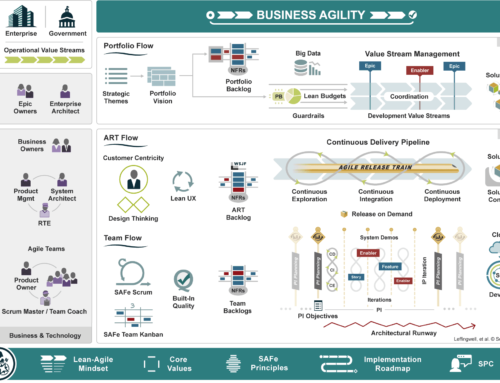“Scrum will highlight every deficiency and impediment that the enterprise has…”
— Ken Schwaber
As teams and businesses adopt Scrum and Agile to their enterprise, they will encounter a host of bumps, roadblocks and obstacles that Scrum practitioners collectively refer to as “impediments.” Impediments are disruptions to the fast flow of value towards the customer and prevent your organization from becoming a market leader. In my experience, Scrum impediments tend to be the leftover habits that were common in waterfall, and no one has replaced them with new, more productive habits.
These impediments are not benign. They need to be removed because, as Ken Schwaber observed, “everything that was hard in waterfall…now has to be done every iteration and [that] is incredibly hard.” Additionally, impediments that are allowed to remain make people feel uncomfortable because they know the old ways of building and shipping software are inconsistent with the new Scrum and Agile principles. If they are not removed, the impediments will drag down morale and put the Agile adoption at risk.
There is a solution, and the process starts with an Impediments Backlog.
1. Create an Impediments Backlog
One of the best ways to make the Scrum impediments visible — and increase the likelihood they will be eliminated — is to use an Impediments Backlog. An Impediments Backlog is a simple list of hurdles, obstacles, snares, deterrents, blockers, and impediments that cause waste in the organization. Give anyone on a Scrum Team, anywhere, ten minutes and I am sure they could create a list of fifteen items.
To have an effective Impediments Backlog, you need two things: 1) the impediments need to be written down; and 2) they need to be publicly available for anyone to review. I find that once the list is made public, then the impediments can be addressed. It is especially important that the items in the Impediments Backlog are prioritized by business leaders and the folks who accept responsibility to resolve the impediments are held accountable as to whether the items have been fixed or not.
Oddly enough, the Impediments Backlog is not discussed in the Scrum community and I rarely see it with clients. However, I have found that as I expand my perspective beyond working with a single Scrum Team, an Impediments Backlog is very helpful as I try to use Scrum across multiple locations and with multiple teams. If you do not have an Impediments Backlog, create one today!
2. Focus on the root cause of the impediment
When I do see an Impediments Backlog with our clients, they tend to focus on alleviating the symptoms our clients are experiencing rather than a way to delve into root cause(s). In these cases, the impediments tend to reflect the local concerns of a single Scrum Team, so eliminating the impediment, i.e. symptom, is not going to make the problem go away. It is merely palliative. Focus on finding the root cause(s) of the impediment(s) and eliminate it/them. To help you find the root cause(s), I recommend using frameworks like the Five Whys or Help Me Understand, from the book Gamestorming. Once the root cause(s) have been identified, this increases the likelihood of seeing the greater and broader impact when the impediment is removed.
3. Get data showing the negative effect of the impediment
After the root cause(s) of the impediment have been found, get the data showing why the impediment is bad. If you are going to change something about the enterprise, senior leaders and decision-makers need to see the evidence. Be prepared to connect the elimination of the impediment to an increase in something a senior leader and executive cares about. Over my many years of helping create change, I have found that the best way to capture the attention of a senior leader is to explain how an impediment negatively impacts quality, customer satisfaction, revenue, time-to-market, employee satisfaction, growth, productivity and/or market differentiation. If you cannot describe the negative business impact of an impediment, you are not going to create a sense of urgency to remove it.
4. Get senior leadership to actually fix the impediment
If you want to fix the impediment, then you must get senior leaders involved in the process of fixing the problem. In his book, Scrum: The Art of Doing Twice the Work in Half the Time, Jeff Sutherland shared a story of how Medco used an Impediments Backlog to hit a critical market date. Medco’s approach was simple. If the Scrum Teams could fix the impediment themselves, they were empowered to fix them. However, if the Scrum Teams could not fix the impediment, they were escalated to the Medco senior managers. Whenever this group of managers met – I think it was every Monday – they discussed any new impediments that had been escalated to their level. By the conclusion of their meeting, each new impediment had a senior manager’s name next to it with the expectation the impediment would be resolved by close-of-business Thursday!
I have another client who calls this group of senior leaders the “Blocker Busters.” Their sole purpose in the organization is to remove waste and get to the root cause of enterprise level impediments. In order for this to work, reach up as high as you can in the organization to find people who care about the issues and have the power to fix any sort of blocker affecting the Scrum Teams. If not, then impediments will remain.
Need help implementing an Impediments Backlog?
Contact us to learn more, or speak to one of our Agile Adoption experts. We also provide Scrum and Agile training if you are interested in continuing your Agile journey!






